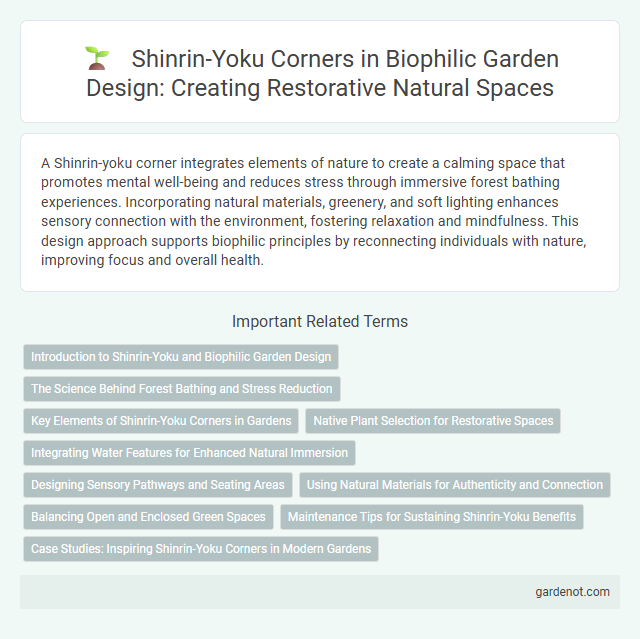A Shinrin-yoku corner integrates elements of nature to create a calming space that promotes mental well-being and reduces stress through immersive forest bathing experiences. Incorporating natural materials, greenery, and soft lighting enhances sensory connection with the environment, fostering relaxation and mindfulness. This design approach supports biophilic principles by reconnecting individuals with nature, improving focus and overall health.
Introduction to Shinrin-Yoku and Biophilic Garden Design
Shinrin-yoku, or forest bathing, is a Japanese practice that immerses individuals in natural forest environments to reduce stress and enhance well-being through sensory engagement. Biophilic garden design integrates Shinrin-yoku principles by creating green spaces that emulate natural forests, featuring native plants, textured foliage, and tranquil water elements to foster a deep connection with nature. These curated environments promote mental restoration, improve air quality, and support biodiversity, aligning with the core goals of biophilic design to harmonize human health with natural ecosystems.
The Science Behind Forest Bathing and Stress Reduction
Shinrin-yoku, or forest bathing, leverages evidence from environmental psychology and immunology to demonstrate stress reduction through biophilic interaction with nature. Exposure to phytoncides, the antimicrobial compounds released by trees, boosts natural killer cell activity and lowers cortisol levels, directly impacting physiological stress markers. Research shows that spending just 20 minutes in a forest environment can significantly enhance mood, reduce blood pressure, and improve immune function, making the Shinrin-yoku corner an effective biophilic design element for wellness spaces.
Key Elements of Shinrin-Yoku Corners in Gardens
Shinrin-yoku corners in gardens emphasize natural elements such as lush greenery, flowing water features, and textured surfaces to stimulate the senses and promote relaxation. Incorporating native plants, shaded seating areas, and gentle pathways enhances immersion in nature, supporting mental well-being and stress reduction. Strategic placement of these elements fosters a calming environment that encourages mindfulness and a deeper connection to the natural world.
Native Plant Selection for Restorative Spaces
Shinrin-yoku corners that incorporate native plant selection enhance restorative spaces by promoting biodiversity and ecological balance. Native plants support local wildlife, improve air quality, and provide a sensory-rich environment that fosters relaxation and mental rejuvenation. Integrating species such as ferns, maples, and wildflowers aligns with biophilic design principles, optimizing health benefits and environmental sustainability.
Integrating Water Features for Enhanced Natural Immersion
Integrating water features in a Shinrin-yoku corner enhances sensory engagement by replicating natural forest streams and waterfalls, which promote relaxation and stress reduction. The presence of flowing water supports biophilic design principles by stimulating auditory senses and creating a tranquil atmosphere that deepens connection with nature. This immersion encourages mindfulness and restorative experiences, boosting overall well-being within indoor environments.
Designing Sensory Pathways and Seating Areas
Shinrin-yoku corners prioritize immersive sensory pathways featuring textured ground surfaces, aromatic plants, and ambient sounds to enhance nature connection and mindfulness. Seating areas incorporate natural materials like wood and stone with ergonomic designs for comfort, encouraging users to pause and engage with the environment. Strategic placement ensures clear sightlines to greenery and maximizes exposure to calming sensory stimuli, fostering restorative experiences.
Using Natural Materials for Authenticity and Connection
Incorporating natural materials like untreated wood, stone, and bamboo in the Shinrin-yoku corner enhances authenticity and deepens the connection to nature. These elements emulate forest environments, promoting sensory engagement and wellness through tactile and visual stimuli. The use of organic textures and colors supports mental restoration by fostering a genuine biophilic experience.
Balancing Open and Enclosed Green Spaces
Shinrin-yoku corners strategically balance open and enclosed green spaces to enhance sensory immersion and mental restoration. Open areas facilitate sunlight exposure and expansive views, while enclosed zones provide intimate, sheltered environments for deep relaxation and stress reduction. This equilibrium supports diverse user preferences and promotes prolonged connection with nature, optimizing the benefits of biophilic design.
Maintenance Tips for Sustaining Shinrin-Yoku Benefits
Maintaining a Shinrin-yoku corner requires regular care such as cleaning natural elements, monitoring humidity levels between 40-60%, and ensuring adequate airflow to replicate forest conditions. Incorporate native plant species and periodically refresh organic materials like moss and wood to sustain the immersive, stress-reducing environment. Consistent maintenance enhances the mental and physical health benefits by preserving the authentic connection to nature essential in biophilic design.
Case Studies: Inspiring Shinrin-Yoku Corners in Modern Gardens
Shinrin-yoku corners in modern gardens integrate native plant species, natural water features, and textured foliage to create immersive sensory experiences that promote relaxation and mental well-being. Notable case studies include Singapore's Gardens by the Bay, where multi-sensory pathways encourage mindfulness, and the Portland Japanese Garden, which combines traditional design with therapeutic green spaces. These implementations demonstrate biophilic design's impact on urban environments by enhancing biodiversity and fostering human-nature connections.
Shinrin-yoku corner Infographic

 gardenot.com
gardenot.com